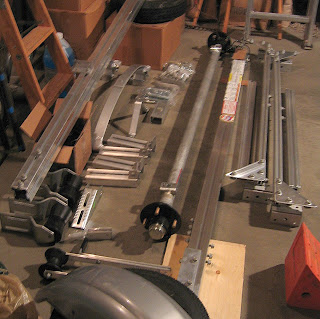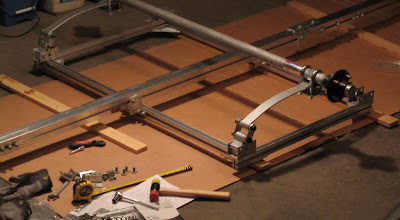What will be rowed must first be towed.
Easier said than done.
First off, I had to make a decision: what kind of trailer should I get?
I actually have an old but trusty trailer for my MX-Ray. I am certain that it would work well for the PMD - should I used it? ...but then I AM planning to sell the MX-Ray and it'll be a lot easier to sell with a trailer which I customized to fit this hull like a glove. Besides, it's not exactly pretty and I feel that a new boat would be a lot happier on a brand new trailer. Okay - that wasn't so hard, was it?
Some discussion about trailers on the PMD Forum provided excellent information.
Ultimately, I opted to buy the trailer that is specifically recommended by Chesapeake Light Craft even though, I have no doubt that a rather less expensive alternative would have done the job just as well.
It was the fact that the Trailex SUT-250-S is an all aluminum product which makes it impervious to rust and - more important to me - very light. I'll be able to handle this trailer much like a launching dolly.
When I placed the order for the trailer, Castlecraft happened to offer just at that time a spare tire and bearing buddies at no additional charge.
Good timing, why - Thank You!
I had been on their web site before and this offer had just popped up. The reason for ordering this trailer through Castlecraft rather than CLC was simply that Castlecraft did not charge for shipping which adds up for four rather large and heavy boxes shipped via UPS. Not that I would have minded to pay a bit extra to support a great company but in this case there was the additional savings on the extras and besides, in recent months I have kept CLC quite busy with orders for supplies.
 I did follow the advice of a fellow PMD builder in customizing the front part of the trailer. Instead of using the front end roller which came with the trailer kit, I ordered a little support bracket...
I did follow the advice of a fellow PMD builder in customizing the front part of the trailer. Instead of using the front end roller which came with the trailer kit, I ordered a little support bracket... ...which allowed me to install a 6" x 12" pad (which I made for this purpose) to provide front end support to the swooping curve of the hull.
...which allowed me to install a 6" x 12" pad (which I made for this purpose) to provide front end support to the swooping curve of the hull.Obviously, the exact location and height will need to be adjusted once the hull sits on the trailer.
Oops!
Sticking it's lengthy tongue out in open air for the first time, it is discovered that a trip to the lake is - perhaps - premature.
Anyway, I still have a number of layers of varnish to do. Once that job is finished I'll have to clear the way out the door to move the hull onto the trailer.
Gudgeons, oarlocks, inspections ports and any other hardware will be installed once it rests on its bunks.
































